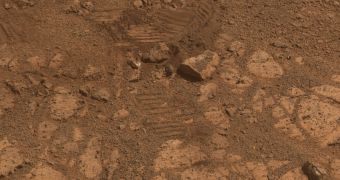Mars Exploration Rover (MER) mission controllers at the NASA Jet Propulsion Laboratory (JPL) in Pasadena, California, have announced recently that the rover Opportunity finally managed to solve a mystery related to the nature of a rock formation called Pinnacle Island.
The jelly donut-like rocky structure puzzled researchers with Opportunity's science team. Eventually, data provided by the explorations robot revealed that Pinnacle Island was once a large rock that was broken apart and moved about by the rover's wheels, earlier this year
The 4-centimeter (1.5-inch) rock caused quite a fuss at JPL in late January, when controllers discovered it suddenly popping up in an image. Opportunity imaged the portion of Martian ground on January 4 and January 8, but Pinnacle Island was not present in the January 4 photo.
Since late January, scientists have been trying to come up with a plausible explanation as to how the rock may have gotten in front of Opportunity. The latest images suggest that the formation originated slightly uphill from its current position, and that the rover dislodged the fragment while driving.
“Once we moved Opportunity a short distance, after inspecting Pinnacle Island, we could see directly uphill an overturned rock that has the same unusual appearance.We drove over it. We can see the track. That's where Pinnacle Island came from,” says researcher Ray Arvidson.
The expert holds an appointment as the deputy principal investigator for the Opportunity mission, and is based at the Washington University in St. Louis. He says that the small explorations robot is currently investigating an area at the rim of Endeavour crater called the McClure-Beverlin Escarpment.
“Our team working on Opportunity's continuing mission of exploration and discovery realizes how indebted we are to the work of people who made the early missions to Mars possible, and in particular to the heroics of Bill McClure and Jack Beverlin,” adds James Rice.
“We felt this was really a fitting tribute to these brave men, especially with the 45th anniversary of their actions coming today,” adds the expert, who is a member of the rover science team, and a researcher at the Planetary Science Institute in Tucson, Arizona.

 14 DAY TRIAL //
14 DAY TRIAL //